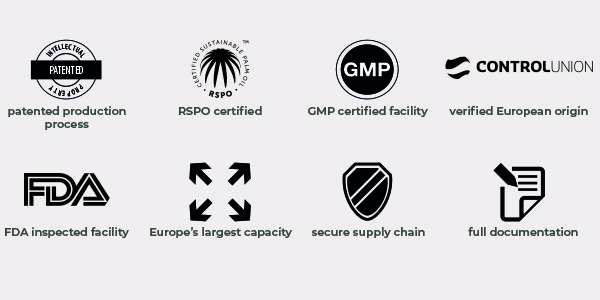Promotional Features
A single multifunctional ingredient disrupting chronic pain management and taking the lead on CBD
Only rarely a nutraceutical ingredient appears with the ability to impact and change daily life for the multitudes in need of effective, safe and side-effect-free management options for chronic pain disorders. With OptiPEA (palmitoylethanolamide), Innexus Nutraceuticals offers companies the opportunity to respond to ever-increasing demands and stimulates innovation beyond what were long thought the limits of nutraceutical applications.
Understanding pain is one of the oldest, and remains among the most pressing, challenges in medicine. Pain is a symptom that screams for attention and intrudes into every aspect of a person's life. Clinicians dread chronic pain: a symptom that brings more patients to their offices than any other—but also the symptom most likely to make professionals feel truly helpless.1
“I learned a lot of interesting things from my conversations with a clinical pain researcher in our OptiPEA sponsor program. One of them was the interesting fact that pain is considered the fifth vital sign after body temperature, heart rate, respiratory rate and blood pressure. However, what I remember most was being confronted again with the dire need clinicians experience for novel solutions in pain management. The challenges of pain management prevailed in those conversations”. -- Samuel Zonneveld, CEO of Innexus Nutraceuticals.
Complex challenges presented to both health professionals and patients have led to a demand for alternative strategies probing beyond steroids, opioids and NSAIDs. Cannabinoids such as cannabidiol (CBD) have often been cited as interesting and effective alternatives for nutraceutical companies to explore. But they come with a complex set of problems of their own, let alone stigma.
Palmitoylethanolamide: The prohomeostatic disruptor
A new solution to meet the demand for alternative pain relief regimens is the bioactive lipid palmitoylethanolamide (PEA), a genuine nutraceutical disruptor in the modern management of chronic pain. The multi-target mechanisms through which PEA sorts prohomeostatic effects breaks entirely with the age-old allopathic adagio of "one compound, one target, one disorder". PEA heralds a new era in chronic pain management based on “according-to-nature” biomodulation of bodily responses to different stimuli and injury.2
PEA as a possible nutritional support strategy for COVID-19
Besides chronic pain, PEA has a wide array of other known health-promoting properties, one being the alleviation of acute virus-induced respiratory stress. In fact, PEA’s immunosupportive effects in influenza and respiratory disorders were the first indications for use. PEA evidences several pertinent, distinctive homeostatic properties, ranging from anti-inflammatory activities to modulation of both the immune response and the endocannabinoid system. Given these properties scientists are considering PEA as a potential novel nutraceutical stratagem in the management of COVID-19.3
Already since March of this year several Italian physicians and scientists have even been advocating the use of PEA for patients suffering from symptoms of COVID-19. This has led to an application, approval and subsequent design of a clinical trial to assess PEA’s effectiveness in coronavirus patients.4
From egg yolk to OptiPEA
Sixty-five years ago American physician Alvin Coburn discovered PEA while he was studying certain egg yolk fractions as potential supplements to the normal diet. In the subsequent decades PEA slid in and out of visibility as it was still poorly understood as a compound. The definitive breakthrough came during the early 1990s. Italian Nobel Prize laureate Dr. Rita Levi-Montalcini provided the impulse for PEA’s clinical revival by unraveling some of PEA’s key mechanisms of action. Not too long after being tipped by Dr. Rita Levi-Montalcini, the Italian company Epitech commercialized PEA in the form of a finished product. After years of development, in 2016 Innexus Nutraceuticals was the first company to launch a branded PEA bulk material under the brand name of OptiPEA. This completed the development cycle of PEA as a nutraceutical ingredient, setting industry standards and unlocking new markets for product developers.
Bridging a gap between nutrition and complex disorders
Besides being a natural solution for both pain relief and immunomodulation, PEA can also be used for a spectrum of other complex disorders, often associated with unmet therapeutic needs, from autoimmune disorders to neurodegenerative disorders and mood disorders. PEA is a single compound that can, whether directly or indirectly, synergistically balance multiple disrupted molecular pathways, thus alleviating various complex clinical disorders. Today, with more than 60 indications for use identified, PEA can be used both as a stand-alone solution and as a core ingredient for unique and targeted formulations.
Do not compromise on your PEA
Suppliers as well as consumers are demanding more from ingredient suppliers. Branding, sustainability and transparency are guiding principles for development and growth. Innexus Nutraceuticals has always embraced these principles, beyond its core focus on quality. With a patented all-European production process, a GMP-certified production environment, FDA-inspected facility and RSPO-certification, they set out a clear vision in leading a market responsive to emergent trends and growing demands, specifically demands that cannot be met with generic materials.
Teaming up with Innexus Nutraceuticals
OptiPEA is PEA molecularly reconstructed from palmitic acid (C16:0), the most common fatty acid in animals. OptiPEA is a transparent, safe and high-quality ingredient produced according to the most stringent European standards. By providing full documentation, formulation assistance and continuous innovation, with OptiPEA Innexus Nutraceuticals offers a proven full-service solution immediately available for application in various finished dosage forms. In addition to OptiPEA, Innexus Nutraceuticals has also developed a water-dispersible version (OptiPEA WDP) with a very clean-label profile. Multiple additional innovations are set to be launched within 2020.
“We take quality, safety and transparency very seriously and are proud of our product standards. Our customers can even visit our GMP production facility in The Netherlands, talk to the chemists, see the production lines in person, and enjoy an very informative day overall. Many of our customers accepted the invitation and left with a solid impression of who we are and what we stand for”. -- Samuel Zonneveld, CEO of Innexus Nutraceuticals.
An ongoing debate: regular PEA vs micronized PEA vs other forms of PEA
As a pioneering PEA manufacturer, Innexus Nutraceuticals is not tied to any specific form of PEA, nor do they simply favor one form over the other. Many human effect studies have shown that regular non-micronized and non-micro-encapsulated PEA is very effective. Innexus Nutraceuticals is open to all options and always tries to think along with customers and consider both context and specific needs. Innovation is of course very welcome from every angle. However, promoting awareness of PEA’s versatility and offering top quality, safety and transparency have been leading objectives.
PEA as superior alternative to cannabidiol (CBD)?
As years have passed by, regulatory problems and quality issues surrounding CBD remain. The cannabimimetic PEA has increasingly been considered a valid alternative in meeting consumer demands in the CBD market segment. CEO of Innexus Nutraceuticals Samuel Zonneveld regards PEA as a superior alternative to hemp-based cannabinoid products. For example, PEA is easier to dose (it is less complex as a single molecule), it extends across more known mechanisms of action, and has a far longer track record.
While PEA shows real promise as a disruptor of chronic pain management, it has definite potential to disrupt the CBD market as well. In practically every area where CBD has known shortcomings or uncertainties, PEA takes the lead when compared one-to-one with CBD, and offers additional benefits physiologically, technically and regulatorily.
That said, CBD- and hemp-derived cannabinoids remain interesting health-promoting compounds. Combinations with PEA will most likely be seen in the coming years. Despite a lack of data there is a valid theoretic rationale and basis to combining PEA with hemp-derived active compounds such as CBD. Even combinations of PEA with THC have been considered in pharmaceutical applications.
References
[1] Crofford LJ. Chronic pain: where the body meets the brain. Transactions of the American Clinical and Climatological Association. 2015;126:167.
[2] Gugliandolo E, Peritore AF, Piras C, Cuzzocrea S, Crupi R. Palmitoylethanolamide and Related ALIAmides: Prohomeostatic Lipid Compounds for Animal Health and Wellbeing. Veterinary sciences. 2020 Jun;7(2):78.
[3] Gigante A, Aquili A, Farinelli L, Caraffa A, Ronconi G, Gallenga CE, Tetè G, Kritas SK, Conti P. Sodium Chromo-Glycate and Palmitoylethanolamide: a Possible Strategy to Treat Mast Cell-induced Lung Inflammation in COVID-19. Medical Hypotheses. 2020 May 19:109856.
[4] www.clinicaltrialsarena.com/news/fsd-pharma-covid-19-trial-design/







